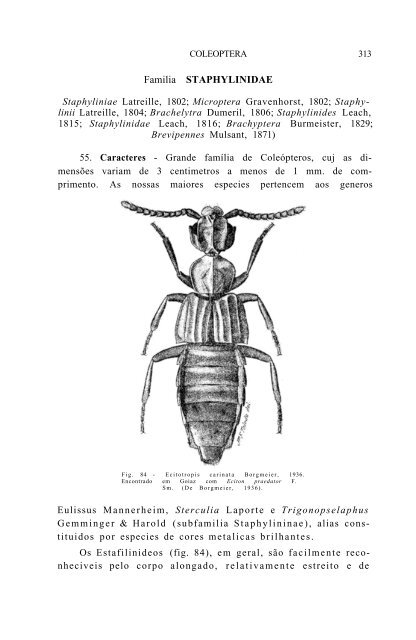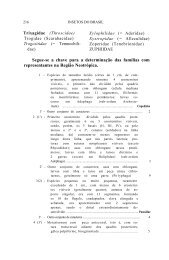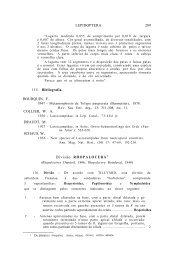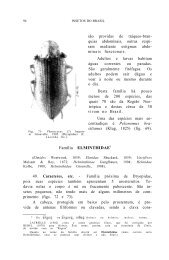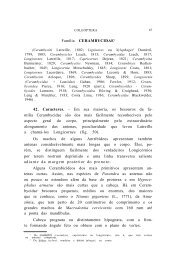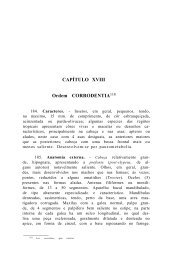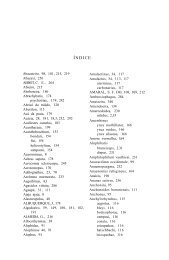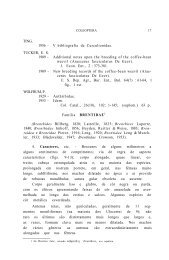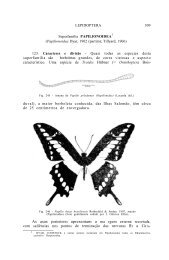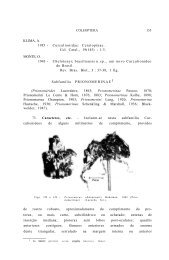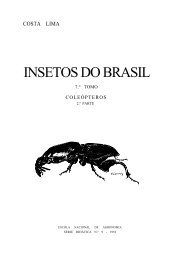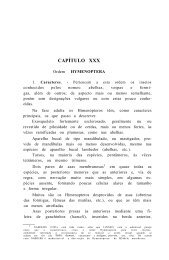FamÃÂlia STAPHYLINIDAE - Acervo Digital de Obras Especiais
FamÃÂlia STAPHYLINIDAE - Acervo Digital de Obras Especiais
FamÃÂlia STAPHYLINIDAE - Acervo Digital de Obras Especiais
Create successful ePaper yourself
Turn your PDF publications into a flip-book with our unique Google optimized e-Paper software.
COLEOPTERA 313<br />
Familia <strong>STAPHYLINIDAE</strong><br />
Staphyliniae Latreille, 1802; Microptera Gravenhorst, 1802; Staphylinii<br />
Latreille, 1804; Brachelytra Dumeril, 1806; Staphylini<strong>de</strong>s Leach,<br />
1815; Staphylinidae Leach, 1816; Brachyptera Burmeister, 1829;<br />
Brevipennes Mulsant, 1871)<br />
55. Caracteres - Gran<strong>de</strong> família <strong>de</strong> Coleópteros, cuj as dimensões<br />
variam <strong>de</strong> 3 centimetros a menos <strong>de</strong> 1 mm. <strong>de</strong> comprimento.<br />
As nossas maiores especies pertencem aos generos<br />
Fig. 84 - Ecitotropis carinata Borgmeier, 1936.<br />
Encontrado em Goiaz com Eciton praedator F.<br />
Sm. (De Borgmeier, 1936).<br />
Eulissus Mannerheim, Sterculia Laporte e Trigonopselaphus<br />
Gemminger & Harold (subfamilia Staphylininae), alias constituidos<br />
por especies <strong>de</strong> cores metalicas brilhantes.<br />
Os Estafilini<strong>de</strong>os (fig. 84), em geral, são facilmente reconheciveis<br />
pelo corpo alongado, relativamente estreito e <strong>de</strong>
314 INSETOS DO BRASIL<br />
lados paralelos, não raro <strong>de</strong>primido, as vezes abaulado, providos<br />
<strong>de</strong> elitros mais ou menos encurtados, transversalmente<br />
truncados atraz, geralmente cobrindo os 2 ou 3 primeiros<br />
urotergitos, ficando, portanto, mais <strong>de</strong> 5 urotergitos <strong>de</strong>scobertos;<br />
estes são fortemente esclerosados, como os respectivos<br />
esternitos; todavia, tanto estes como aqueles, são <strong>de</strong> tal modo<br />
articulados, que o abdomen apresenta franca mobilida<strong>de</strong>. Daí<br />
habitualmente andarem com o abdome voltado para cima,<br />
principalmente quando atacados.<br />
Cabeça prognata, bem visivel <strong>de</strong> cima; as vezes, porem,<br />
<strong>de</strong>flectida e mais ou menos escondida. Antenas geralmente<br />
<strong>de</strong> 11 segmentos filiformes, moniliformes ou fracamente se<br />
dilatando para o apice. Olhos, via <strong>de</strong> regra, presentes e<br />
gran<strong>de</strong>s; em algumas especies, principalmente nas cavernicolas,<br />
ausentes. Ocelos geralmente ausentes; em alguns (Omaliinae)<br />
ha um par, noutros vê-se somente um ocelo no meio<br />
do vertex (alguns Proteininae).<br />
Tarsos pentameros na maioria das subfamilias. Observa-<br />
-se porem, extraordinaria varieda<strong>de</strong> <strong>de</strong> formulas tarsais, como<br />
sejam: 4-5-5: Larinota, Xenodusa (Myrmedoniini), Crematoxenini,<br />
Philaeamatini, Atethini, Hoplandriini, Pronomaeini<br />
(todas da subfamilia Aleocharinae); 5-4-4: Tanygnathus<br />
(Staphylininae); 4-4-5: Liparocephalus e Myllaenini (Aleocharinae)<br />
; 4-4-4: Leptanillophilini, Mimecitonini, Ecitogastrini,<br />
Oligotini, Hygronomini (Aleocharinae), Hypocyptini-Tachyporinae);<br />
3-3-3: Oxytelini (Oxytelinae); 2-2-2: Leptotyphlinae.<br />
Asas, em geral bem <strong>de</strong>senvolvidas, dobrando-se perfeitamente<br />
sob os elitros encurtados.<br />
Normalmente eneontram-se 6 urosternitos bem visiveis,<br />
às vezes 7.<br />
Em varias especies termitofilas o abdome adquire gran<strong>de</strong><br />
<strong>de</strong>senvolvimento (fisogastria) e, em algumas, apresenta prolongamentos<br />
membranosos mais ou menos salientes (fig. 85).<br />
Larvas campoa<strong>de</strong>rformes, algo parecidas com os adultos,<br />
atiras, bem características, pois apresentam, no 9 ° uromero,
COLEOPTERA 315<br />
urogomphi moveis, <strong>de</strong> 1, 2 ou 3 segmentos (exceto nos primeiros<br />
estadios <strong>de</strong> alguns Aleocharinae, que não os apresentam).<br />
Hábitos e importância econômica - Há cêrca <strong>de</strong> 20.000<br />
especies <strong>de</strong>scritas, das quais pouco mais <strong>de</strong> 5. 000 são da região<br />
Neotrópica.<br />
Fig. 85 - Tyreoxenus autuorii Silvestri, 1946 (Staphylinidae) (De<br />
Silvestri, 1946 a, fig. VIII).<br />
Tanto os Estafilini<strong>de</strong>os adultos como as larvas vivem,<br />
como saprofagos, em materia organica vegetal ou animal,<br />
inclusive escrementos e cadaveres. Habitualmente são predadores,<br />
atacando quaisquer presas ou <strong>de</strong>terminadas especies.<br />
Tambem são encontrados frequentemente <strong>de</strong>ntro da corola<br />
das flores, alimentando-se <strong>de</strong> polem. Algumas especies são<br />
fungivoras e outras <strong>de</strong> habitos fitofagos.<br />
Todavia o grupo <strong>de</strong> Estafilini<strong>de</strong>os mais interessante sob<br />
o ponto <strong>de</strong> vista biologico é representado pelos que vivem em<br />
comensalismo, mutualismo ou simbiose com formigas e<br />
termitas.
316 INSETOS DO BRASIL<br />
Realmente, no grupo dos mirmecofilos e termitofilos, os<br />
Estafilini<strong>de</strong>os, principalmente os representantes da subfamilia<br />
Aleocharinae, são os mais importantes pela quantida<strong>de</strong><br />
das especies, superior a <strong>de</strong> quaisquer outros insetos com tais<br />
habitos.<br />
Fig. 86 - Ecitocryptus sulcatus BorgmeIer. Encontrado em<br />
Golaz com Eeiton schlechtendali Mayr. (De Borgmeier, 1936).<br />
Uns vivem simplesmente como sinecetos 1 ou comensais<br />
propriamente ditos, outros como sinéctros 2 , outros como sinfilos<br />
(<strong>de</strong> com; amigo). Neste ultimo caso, em troca<br />
do alimento que lhes é fornecido, dão a secreção inebriante<br />
das glandulas anexas aos tricômas 3 que possuem, em maior<br />
ou menor quantida<strong>de</strong>, aos lados do abdome.<br />
Os sinectros, predadores, <strong>de</strong>voram as larvas dos seus<br />
hospedadores e <strong>de</strong>les se <strong>de</strong>fen<strong>de</strong>m pela conformação e esclerose<br />
do corpo ou, como se observa frequentemente em especies<br />
1 De<br />
2 De<br />
De<br />
pelos.<br />
(syn),<br />
(syn),<br />
com;<br />
(oikos), casa.<br />
com;<br />
(ectra), ódio, inimiza<strong>de</strong>.<br />
(trix, trichos), pêlo, mais o sufixo (ôma), aglomerado <strong>de</strong>
COLEOPTERA 317<br />
ecitofilas (hospe<strong>de</strong>s <strong>de</strong> formigas do genero Eciton), mimetisando<br />
formiga <strong>de</strong> maneira verda<strong>de</strong>iramente impressionante<br />
(fig. 86).<br />
Fig. 87 - Amblyopinus gahani Fauvel (Staphylinidae)<br />
(C. Bruch <strong>de</strong>t. e fot.).<br />
Outro grupo interessante <strong>de</strong> Estafilini<strong>de</strong>os é o das especies<br />
<strong>de</strong> Amblyopinus Solsky (subfamilia Amblyopininae), (fig.<br />
87) ectoparasitos <strong>de</strong> ratos e gambás (v. trabalhos <strong>de</strong> BRUCH<br />
(1936), COSTA LIMA (1927, 1936), FONSECA (1938) e ZIKÀN<br />
(1939) e, na America do Norte, <strong>de</strong> NOTMAN (1923) e SEEVERS<br />
(1944).
318 INSETOS DO BRASIL<br />
No Brasil, como em outras partes do mundo, observam-se,<br />
em certas regiões, casos <strong>de</strong> <strong>de</strong>rmatite purulenta causada por<br />
Estafilini<strong>de</strong>os, estudados por PIRAJÁ DA SILVA (1912), DALLAS<br />
(1930, 1933, 1934), GOELDI (1913), NEIVA e PENNA (1916),<br />
CAMPOS (1927), FRÓES (1934) e PICKEL (1940).<br />
Tratam-se <strong>de</strong> lesões produzidas<br />
pela secreção das glândulas pigidiais<br />
dos chamados "potós", espécies do gênero<br />
Pae<strong>de</strong>rus (subfamília Pae<strong>de</strong>rinae)<br />
(fig. 88).<br />
Das oitenta e tantas especies <strong>de</strong>ste<br />
genero encontradas na região Neotropica,<br />
citam-se, como vesicantes,<br />
em nosso território: P. amazonicus<br />
Sharp, 1876; P. brasiliensis Erichson,<br />
1840; P. columbianus Laporte, 1834;<br />
P. fuscipes Curtis, 1826 e P. goeldi<br />
Wasmann.<br />
A secreção do potó, segundo PI-<br />
RAJÁ DA SILVA, possue proprieda<strong>de</strong>s<br />
Fig. 88 - Pae<strong>de</strong>rus sp.<br />
(Staphylinidae) (Lacerda causticas e vesicantes a pele, <strong>de</strong>terfot.).<br />
minando eritêma, orurido, vesículação<br />
e ulceração ,às vêzes extensas e numerosas, rebel<strong>de</strong>s<br />
ao tratamento e <strong>de</strong> cicatrisação lenta, localisando-se nos braços,<br />
nas pernas e no pescoço e po<strong>de</strong>ndo alcançar até uma<br />
polegada <strong>de</strong> diametro.<br />
Dentre as especies <strong>de</strong> Estafilini<strong>de</strong>os predadores <strong>de</strong>ve ser<br />
citado Belonuchus rufipennis (Fabricius, 1801) (= formosus<br />
Grevenhorst, 1806) (subfamilia Staphylininae), provavelmente<br />
a especie ha muitos anos observada no Brasil atacando<br />
larvas <strong>de</strong> moscas <strong>de</strong> frutas e recentemente estudada por<br />
SILVESTRI (1945), que em 1937 levou para a Italia exemplares<br />
vivos, apanhados em São Paulo, <strong>de</strong>predando tais larvas<br />
frugivoras.<br />
Agora que se cogita em alguns paizes da introdução <strong>de</strong>ste<br />
Estafilini<strong>de</strong>o para combater tal praga, parece-me interessante<br />
transcrever os seguintes informes, relativos ao inseto, <strong>de</strong>
COLEOPTERA 319<br />
FROGGATT (1919), <strong>de</strong> R. VON IHERING e <strong>de</strong> C. BOLIVAR PIELTAIN<br />
(1946):<br />
"The other great fruit pest, or rather "group of<br />
fruit pests, are the fruit flies, of which the cosmopolitan<br />
species Ceratitis capitata is known in Australia as the<br />
Mediterranean Fruit Fly. We have another example of<br />
an evi<strong>de</strong>ntly worthles and much praised parasite for this<br />
fly in the notorious Staphylinid beetle, said to be a<br />
complete parasite of this particular fruit-fly. It was<br />
collected in Bahia, Brazil, and introduced into Western<br />
Australia by their entomologist, who take several trips<br />
to that part of South America un<strong>de</strong>r the impression that<br />
this was the native home of this particular fruit-fly.<br />
Won<strong>de</strong>rful stories were told of its voracity and its<br />
<strong>de</strong>adly ennemy to fruit-fly maggots and pupae; how it<br />
had been securely established at great cost to that State<br />
in their citrus orchards; and it was urged by our fruit-<br />
-growers that we should obtain this parasite at any cost;<br />
yet ir had not been proved that it had killed a single<br />
fruit-fly maggot in a West Australian orchard. So much,<br />
however, was called to this reputed parasite in the fruit-<br />
-growing world, that the entomologists of Cape Colony<br />
and Natal urged their respective Governments to investigate<br />
the matter. Cape Colony voted £500; Natal, £375;<br />
Transvaal, £300; and Orange River Colony, £125; or a<br />
total of £1,300 to provi<strong>de</strong> funds. Thus provi<strong>de</strong>d, Messrs.<br />
Lounsbury and Fuller set out for Bahia to segure supplies<br />
of this Staphylinid beetles, to introduce them into the<br />
South Africa orchards.<br />
How they succee<strong>de</strong>d, and what they thought of the<br />
value of this parasite, is told in Mr. Lounsbury's Report,<br />
"Natural Enemies of the Fruir Fly", published in the<br />
Agricultural Journal of Cape Colony, September and<br />
October, 1905.<br />
Both these gentlemen are strong advocates of the<br />
introduced parasite theory, so that their reports must<br />
be taken as an impartial review of the whole question;<br />
and though Mr. Fuller did not remain very long in South<br />
America, Mr. Lounsbury took an exten<strong>de</strong>d trip down the<br />
South America coast, but found even worse conditions in<br />
fruit-fly infestation than he had in South Africa. In<br />
the district round Bahia, <strong>de</strong>scribed by the West Australian<br />
entomologists as being "the fruir district of Brazil" and
320 INSETOS DO BRASIL<br />
yet almost free from fruit-flies on account of parasites,<br />
Lounsbury said he found no commercial orchards; and<br />
speaking of the Brazilian cherry be says: "My impression<br />
is that nearly every fruit gets punctured ir allowed to<br />
fully ripen upon the plant". Mr. Fuller counted 280<br />
puparia form one lot of pitangas he gathered, and from<br />
them emerged 124 adult fruit-flies and 77 parasites; from<br />
another lot he collected on llth March in the same locality<br />
be obtained 141 puparia, and from these emerged 47<br />
fruit-flies and 28 parasites. The latter consisted of 221<br />
fruits-large and small, ripe and unripe shaken from the<br />
bushes. The extent of parasitism in both cases works<br />
out at about 38 per cent.<br />
The parasite is a minute wasp (Opiellus trimaculatus).<br />
Fuller says: "The effective parasitism of this species<br />
reaches its maximum in small fruits with thin pulp, and<br />
the effectiveness falls apreciably in proportion to the<br />
<strong>de</strong>pth or thickness of the pulp of the fruit attacked by<br />
the fly."<br />
None of these hymenopterous parasites, though so<br />
abundant, were consi<strong>de</strong>red sufficently effective, and no<br />
efforts were ma<strong>de</strong> to introduce them into Africa. It was<br />
the Staphylinid beetle that these investigators had gone<br />
to procure, bur with careful search they could not find<br />
any. It may have been the wrong season, bur it does not<br />
say much for the parasite if the fruit-flies were busy all<br />
the year and the beetles only a few months. In fact,<br />
the case was that the fruir had become rotten with fruit-<br />
-fly maggots, and fall to the ground before the predaceous<br />
scavenger beetles could take a hand in the <strong>de</strong>struction<br />
of the maggots.<br />
Messrs. Lounsbury and Fuller returned to South<br />
Africa without getting a single effective parasite, or even<br />
seeing a Staphylinid beetle ar work in the orchards, anal<br />
Mr. Fuller's remarks in the journal of the Natal Department<br />
of Agriculture are even more emphatic than Mr.<br />
Lounsbury in their con<strong>de</strong>mnation of the Staphylinid<br />
beetle.<br />
Yet, in his report, "Introduction of the Fruit-fly<br />
Parasite" (Journal of the Department of Agriculture,<br />
1904), Mr. Compere conclu<strong>de</strong>d with the following statement:<br />
"The Staphylinidae beetles beyond question <strong>de</strong>stroy<br />
a great number of parasites as well, eating every
COLEOPTERA 321<br />
maggot with which they come in contact, not discriminating<br />
between those parasited and those that are not."<br />
He says, too: "in Brazil, the same as in India, nature's<br />
forces controlling these <strong>de</strong>sctructive fruit-flies is complete."<br />
Only a few months later Lounsbury and Fuller<br />
found that all down the Brazilian coast ir was difficult<br />
to obtain a fruir that had not been punctured by a fly.<br />
The officers of the West Australian Department of Agriculture<br />
have known quite well for some years that this<br />
beetle is not only no check upon fruit-fly in the West<br />
Australian orchards, but that it had never even established<br />
outsi<strong>de</strong> their insectarium, and there they died out;<br />
yet they still publish glowing accounts of its value, as<br />
can be seen in their official bulletin, "The Selectors Gui<strong>de</strong><br />
to the Crown Lands of Western Australia." On page 20,<br />
the successful introduction is stated as a fact "Fruit<br />
Pests: Successful Work of the State Entomologist. "<br />
(FROGGATT).<br />
"Deixaremos <strong>de</strong> lado o besourinho da familia dos<br />
Staphylinidae que Compère <strong>de</strong>scobrio na Bahia (e cujo<br />
nome scientifico nunca se soube) porque esta fórma só<br />
se alimenta <strong>de</strong> larvas <strong>de</strong> moscas que encontra nas fructas<br />
cahidas. Ora, como mostraremos na conclusão <strong>de</strong>ste trabalho,<br />
é absolutamente necessario, indispensavel, que em<br />
um pomar bem tratado as fructas cahidas sejam recolhidas<br />
o mais cedo possível. Portanto o besourinho só viria<br />
fazer trabalho <strong>de</strong> que nós mesmos nos <strong>de</strong>vemos encarregar.<br />
E, alem disto, elle o fará <strong>de</strong> modo menos seguro e, ainda,<br />
com prejuizo para nós. Menos seguro, porque não é certo<br />
que o besourinho acorra logo ao cahir da fructa, e portanto<br />
po<strong>de</strong>rá dar tempo a que todas as larvas <strong>de</strong> mosca<br />
se enterrem e lhe escapem; e, comendo a larva, o pequeno<br />
polícia nos cauza prejuízo, porque elle comerá também<br />
as larvas parasitadas, que, si as <strong>de</strong>ixassemos tomar o seu<br />
<strong>de</strong>senvolvimento, viriam fornecer-nos bom numero <strong>de</strong> inimigos<br />
naturaes das moscas. Nós, se nos <strong>de</strong>rmos o trabalho,<br />
po<strong>de</strong>mos facilmente salvar esses nossos aliados e, si<br />
o não fizermos, e apenas inutilizarmos as fructas, ainda<br />
assim obteremos o mesmo resultado que o besouro, isto<br />
é, a <strong>de</strong>struição das larvas, com a vantagem <strong>de</strong> fazermos<br />
trabalho completo, enquanto que o besouro po<strong>de</strong> faltar."<br />
(R. VON IHERING, 1912).
322 INSETOS DO BRASIL<br />
HALLAZGO DE COLEOPTEROS ESTAFILINIDOS PREDADORES DE LAS<br />
MOSCAS DE LAS FRUTAS Y SU POSIBLE EMPLEO EN LA LUCHA<br />
BIOLOGICA CONTRA ESTAS<br />
Durante su estancia en Brasil en 1937, el distinguido<br />
entomólogo italiano Prof. Filippo Silvestri, tuvo ocasión<br />
<strong>de</strong> observar en el Estado <strong>de</strong> São Paulo un Coleóptero<br />
Estafilínido, el Belonuchus formosus Grav., que tanto en<br />
el estado <strong>de</strong> larva como <strong>de</strong> adulto vive a expensas <strong>de</strong> las<br />
larvas <strong>de</strong> Dipteros Tripaneidos.<br />
Pensando en la posibilidad <strong>de</strong> utilización <strong>de</strong> dicho<br />
insecto en la lucha biológica contra las moscas <strong>de</strong> las<br />
frutas <strong>de</strong> Europa (Ceratitis capitata, Dacus oleae y Rhagoletis<br />
cerasi), lIevó, al volver a su país en noviembre <strong>de</strong><br />
dicho año, un cierto número <strong>de</strong> ejemplares para intentar<br />
aclimatarlos en su laboratorio <strong>de</strong> Portici (Nápoles) y<br />
liberarlos más tar<strong>de</strong> en los lugares en que existe la plaga,<br />
cosa que hizo <strong>de</strong>s<strong>de</strong> 1938 a 1941.<br />
La cría <strong>de</strong>l estafilínido se efectuó en cajas <strong>de</strong> zinc<br />
<strong>de</strong> variadas dimensiones, utilizando para la alimentacion<br />
las larvas contenidas en aceitunas atacadas por Dacus<br />
oleae; más tar<strong>de</strong> con cerezas infestadas por Rhagoletis<br />
cerasi; <strong>de</strong>spués con frutos parasitados por Ceratitis<br />
capitata, y, finalmente, a falta <strong>de</strong> esta última mosca, que<br />
durante tres afios no fué observada en la Calabria (<strong>de</strong>l<br />
1940 al 1942), multiplicó en gran cantida d una especie<br />
<strong>de</strong> Drosophila, valiéndose <strong>de</strong> diversas frutas, según los<br />
meses, puestas en las caias <strong>de</strong> cría. A expensas <strong>de</strong> las<br />
larvas <strong>de</strong> estas mosquitas, pudo ser continuada normalmente<br />
la multiplicación <strong>de</strong>l Belonuchus durante todo el<br />
año <strong>de</strong> 1942.<br />
De 1939 al 1941 fueron liberados por el Prof. Silvestri<br />
cerca <strong>de</strong> 9000 ejemplares, en la siguintes forma: 799 en<br />
la Campania; 6871 en CaIabria y 1.165 en Sicilia.<br />
Si bien hasta ahora no se pue<strong>de</strong> <strong>de</strong>cir si la aclimatación<br />
se ha verificado o no, para saber lo cual se harán<br />
muy pronto las investigaciones necesarias, es <strong>de</strong> gran<br />
interés resaltar el valor <strong>de</strong>l ensayo <strong>de</strong>l Prof. Silvestri,<br />
que pone en manos <strong>de</strong> los entomólogos un nuevo elemento<br />
<strong>de</strong> lucha contra las temidas moscas <strong>de</strong> las frutas.<br />
Es interesante consignar también, que los Dres. A. C.<br />
Baker, W. E. Stone, C. C. Plummer y M. McPhail, en su<br />
valioso trabajo sobre la mosca mexicana <strong>de</strong> las frutas<br />
Anastrepha lu<strong>de</strong>ns (Loew), publicado en Washington
COLEOPTERA 323<br />
pocos meses antes <strong>de</strong>l <strong>de</strong> Silvestri, señalan coinci<strong>de</strong>ntemente<br />
la existencia <strong>de</strong> un Estafilinido predador <strong>de</strong> las<br />
larvas, que mencionan como Xenopygus analis (Er.), y<br />
que fué observado por el Dr. Stone en Cuernavaca.<br />
E1 Dr. Baker y sus colaboradores, si bien no indican<br />
la posibilidad <strong>de</strong> empleo <strong>de</strong>l estafilínido por ellos hallado<br />
en la lucha biológica, sí dan muy valiosos datos <strong>de</strong> su<br />
comportamiento con las larvas, señalando que los estudios<br />
realizados en el insectario hicieron ver que un sólo estafilínido'<br />
pue<strong>de</strong> <strong>de</strong>struir quizás hasta 242 larvas (en el<br />
grupo <strong>de</strong> control sólo murieron 28). E1 término medio <strong>de</strong><br />
larvas atacadas diariamente se halla entre 1, 17 y 2. La<br />
longevidad para X. analis dió cifras mayores 178 días)<br />
en los ejemplares mantenidos a expensas <strong>de</strong> frutas y<br />
agua, que en los sostenidos con larvas y agua (137) dias.<br />
Alguna <strong>de</strong> las larvas mantenidas únicamente com agua<br />
llegó a vivir 83 días.<br />
Los autores norteamericanos observaron que el estafilínido<br />
practica agujeros circulares en el fruto, por los<br />
que penetra en busca <strong>de</strong> las larvas <strong>de</strong> mosca, habiéndose<br />
visto que a veces limpia por completo algunos frutos,<br />
como mangos, si bien no se introducen tan rápidamente<br />
en éstos como lo hacen en las guayabas. Un estafilínido<br />
penetró consecutivamente en diez guayabas. A veces, en<br />
un mismo fruto pue<strong>de</strong>n apreciarse dos o tres agujeros<br />
<strong>de</strong> entrada. Los predadores logran localizar y'<strong>de</strong>struir<br />
la mayor parte las larvas contenidas en dichos frutos.<br />
Los datos que entece<strong>de</strong>n hacen ver que quizás también<br />
el Xenopygus analis pueda ser utilizado en la lucha<br />
biológica contra la mosca mexicana <strong>de</strong> las frutas.<br />
Conviene hacer notar, finalmente, que los dos estafilínidos<br />
predadores señalados por el Prof. Silvestri y el<br />
Dr. Baker y sus colaboradores son géneros <strong>de</strong> la misma<br />
subfamilia y tribu, próximos entre sí, e inmediatos ambos<br />
a Philonthus.<br />
Si nos atenemos al Catálogo <strong>de</strong> Coleópteros <strong>de</strong> Richard<br />
E. Blackwel<strong>de</strong>r, la especie utilizada por Silvestri <strong>de</strong>berá<br />
ser citada como Belonuchus rufipennis Fabr., <strong>de</strong>l cual<br />
formosus Grav. es un sinónimo. Y la señalada por Baker<br />
y colaboradores no pertenece realmente al género Xenopygus,<br />
sino al Holisus, y <strong>de</strong>berá llamarse Holisus analis."<br />
(C. BOLIVAR PIELTAIN).


